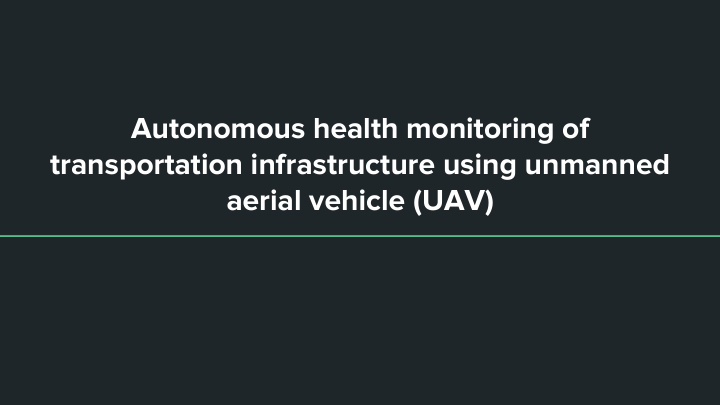



Autonomous health monitoring of transportation infrastructure using unmanned aerial vehicle (UAV)
Isaac Bries sdmay18-25 Kevin Yen Quade Spellman Rishab Sharma Client : Halil Ceylan Molly Hayes Advisor : Halil Ceylan, Shuo Yang Nathan Conroy
Project Plan
Problem Statement ● Cost-effective health monitoring ● Safety of: ○ Bridges Construction work ○ ○ Roads
Solution ● UAV Collecting Data ● ● Evaluate health of infrastructure
Functional Requirements ○ Live feed and on board storage Thermal camera ■ ■ HD Camera ○ 45+ min flight time ○ Fly in 30 mph winds, light rain Line of sight flight ○ ○ Scan bridges, roads, and windmills
Non-Functional Requirements ● Easy to use Clear documentation ○ ● Cost effective ○ Limited budget ● Reliable ● Easy to maintain ● Drone pilot license
Other Constraints and Considerations ● Lots of research needed Parts are expensive ○ ○ No prior UAV experience No civil engineering knowledge ○ ● Avoid crashing the drone ○ Parts are still expensive ○ Delivery time ● FCC and FAA regulations
Potential Risks and Mitigation ● Drone Failure Mechanical failure ○ ■ Hexacopter design, allowing for 2 motors to fail Flight system hardware failure ○ ■ Redundant sensors and speed controllers Low power ○ ■ Multiple battery monitors and warnings Communication Failure ○
Potential Risks and Mitigation (cont.) ● Unfavorable flight conditions Bridges ○ ○ Rain IP water and dust resistant rated components ■ ■ Housing for electronics High Wind ○ ■ Large wing span of drone Powerful motors ■
Market Survey ● TerraHawk CW-30 Hybrid Vertical take and fixed wing ○ ○ Phoenix Lidar Systems Lidar Only ○ ● Flir Aerial thermal imaging kits ○ Flir Thermal cameras + DJI drone systems ● InfraDrone ○ Iowa State Startup 3D mapping and analysis ○
Resource/Cost Estimate System Costs Flight System $4,981 $5,598 Imaging System (Projected) Total Cost $10,579 Resource Costs Total Weight 8.8 kg / 19.3 lb Thrust (60% Throttle) 35.4 kg / 78.0 lb 30-40 minutes Battery Life (60% Throttle)
Project Milestone ● What we’ve done Increased knowledge base ○ ○ Experienced setbacks Created a solid design ○ ● Schedule of tasks for this semester ○ Order parts by November Drone flight by end of semester ○
System Design Imaging System Hardware Flight System Software Flight System
Imaging System Original Plan: Current Plan: ● GoPro Hero 4 or 5 ● DJI Zenmuse Z3 ○ 4K video ○ 7x zoom Lots of available gimbals Designed for industrial applications ○ ○ ○ Little to no zoom ○ Haven’t gotten approval yet Flir Vue Flir Vue Pro R ● ● ○ Discontinued ● No LiDAR ● Velodyne LiDAR Puck ○ For now Not precise enough ○ ○ $8,000 (cheapest we found)
Video Transmission ● Frequency 5GHz ○ ■ Signal offers better data rate Range ● ○ Maximum range is line of sight ● Interference Radio ○ ○ Other devices on the drone 3 Channel Switch ● ○ Allows switching between 3 cameras using 1 output
Hardware Flight System ● Frame decision Very limited market for drone frame ○ ○ Wind resistance Storage Space ○ ● Motor & Propellers ○ Allows heavy loads ○ Power efficient ● Electronic Speed Controller Need to regulate motor speed ○
Hardware Flight System (cont.) ● Remote Controller Status Bar ○ ○ Easily programmable Sufficient Channels ○ ● Battery ○ Power output ○ Duration ○ Weight
Software Flight System ● ArduPilot Open source ○ ○ Autonomous flight capabilities Mission Planning ○ ○ Real time operating system Ground Station ● ○ Many options thanks to MavLink protocol ○ Windows, OS X, Linux, iOS and Android options ○ Mission Planning ○ Drone flight and camera control ○ Open source options
Test Plan ● Flight Simulations ArduPilot ○ ○ SITL Simulation Data Transfer ● ○ Video Transmission ○ Data Storage ● Battery Life/Flight Time ○ Field Tests
Prototype ● Fixed Wing vs hexacopter Stability ○ ○ Ease of build and operation Methods to store image data ● ● Streaming video devices ○ Laptop vs tablet Orientation of sensors ● ○ Where and how are they being put onto the drone (via frame, gimbal etc.)
Prototype (cont.) ● Hexcopter Stability benefit ○ ○ Ease of build and operation Data stream implementation ● ○ All current imaging devices have onboard storage. ● Stream video on tablet Portability ○ ● 3D print own gimbal ○ More customizability
Current Project Status ● In Progress ● Completed Camera model choice Researched and ordered flight ○ ○ ○ Simulation Ardupilot related hardware FAA Certification Assembled drone frame ○ ○ ■ Schedule Practice test ■ ○ Motor, esc, propellers - waiting on parts Testing individual parts working condition. ○ ○ Gimbal design
Task Responsibility of Each Project Member ● Nathan Conroy - Software Lead : software library selection, flight hardware research ● Kevin Yen - Hardware lead : gimbal design, frame and signal transmission research ● Quade Spellman - Meeting facilitator : thermal research, helped with video transmission research ● Rishab Sharma - Report Manager , camera, battery research ● Molly Hayes - Meeting Scribe : camera and gimbal research ● Isaac Bries - Test Engineer : purchase proposal, test environment design
Plan for Next Semester ● Purchase all parts; HD Camera, Thermal, etc. Assign Software and Hardware jobs ● ● Finish building the drone; calibration, storing data, etc. ● Documentation - user manual ● Test, Test, Test! Have solution finished by mid-April ●
Questions?
Drone Data Schematic
Ground Station Data Schematic
Recommend
More recommend